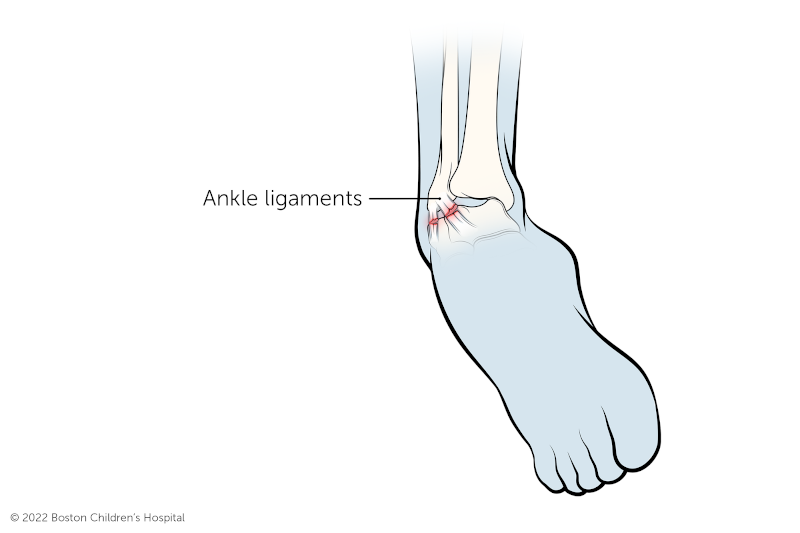Ankle Sprain | Symptoms & Causes
What are the symptoms of an ankle sprain?
The ankle is tender, swollen, and possibly discolored on the outside, below and just in front of the ankle bone. Typically, the bone is not as tender as the area above and in front of it. Some people hear a "popping" sound at the time of the injury.
What causes an ankle sprain?
Any movement that causes the ligaments of the ankle to stretch farther than they naturally can.
- a fall that causes your ankle to twist
- landing awkwardly on the foot while jumping or pivoting
- walking, running, or playing on uneven surfaces
Ankle Sprain | Diagnosis & Treatments
How does a doctor know my child has an ankle sprain?
To make sure there are no other injuries associated with your child's ankle sprain, your child's doctor may require:
- bone scan: a nuclear imaging method to evaluate any degenerative and/or arthritic changes in the joints; to detect bone diseases and tumors; to determine the cause of bone pain or inflammation
- x-ray: a diagnostic test which uses invisible electromagnetic energy beams to produce images of internal tissues, bones, and organs onto film
- magnetic resonance imaging (MRI): a diagnostic procedure that uses a combination of large magnets, radio frequencies, and a computer to produce detailed images of organs and structures within the body.
- radionuclide scans: nuclear scans of various organs to determine blood flow to the organs
- computerized tomography scan (also called a CT or CAT scan): a diagnostic imaging procedure that uses a combination of x-rays and computer technology to produce cross-sectional images (often called "slices"), both horizontally and vertically, of the body; a CT scan shows detailed images of any part of the body, including the bones, muscles, fat, and organs. CT scans are more detailed than general x-rays.
How can I take care of this at home, right away?
Use the following acronym for the initial care of all acute injuries: R.I.C.E.
- rest
- ice
- compression
- elevation
Place ice on the injured area for 20 to 30 minutes each hour. Do not put the ice directly on the skin because it can cause frostbite. Instead, wrap the ice in a wet towel or cloth to protect the skin.
But remember — only a doctor can tell you how bad the injury is.
How does a doctor treat an ankle sprain?
Rehabilitation can begin a few days after the injury, when the swelling starts to go down. There are three goals to aim for in rehabilitation.
Restore motion and flexibility.
- Gently move the ankle up and down.
- After five to seven days, start restoring motion to the hind foot by turning the heel in and out.
- You should also begin to restore flexibility to the calf muscles. One way to do this is to face a wall with one foot in front of the other and lean forward with your hands on the wall, and bend the front leg while keeping the back leg straight and both heels on the floor. Lean forward until you feel a gentle stretch, and hold for 10 seconds.
- Switch legs and repeat.
Restore strength.
After 60 to 70 percent of the ankle's normal motion has returned, you can begin strengthening exercises using a rubber tube for resistance.
- Fix one end of the tube to an immovable object like a table leg, and loop the other end around the forefoot.
- Sit with your knees bent and heels on the floor.
- Pull your foot inward against the tubing, moving your knee as little as possible.
- Return slowly to the starting position. Repeat with the other foot.
- You can also sit on the floor with your knees bent and the tube looped around both feet. Slowly pull outward against the tube, moving your knee as little as possible.
- Return slowly to the starting position. Repeat with the other foot.
- Restore balance.
- As strength returns, balance is restored by standing on the injured leg, hands out to the sides.
- You may want to warm the ankle before doing these exercises by soaking it in warm water. Warmed tissue is more flexible and less prone to injury.
- Use ice when finished with the exercises to minimize any irritation to the tissue caused by the exercise.
When can I return to sports?
Return to sports only after you have met these goals:
- you have full range of motion in all directions (up and down, side to side, and in and out)
- you have good strength in all muscles around the ankle
- you have good balance
- you have no pain or swelling with exercise or activity
Should I use a brace when I play sports?
Taping the ankle or using a brace for support can help prevent re-injury. There are many different types of braces, some made of neoprene, some made of elastic material, and some with extra straps or ties for support. Select a brace that feels like it gives you the best support for the activity you want to do.
- Braces with straps or ties generally provide the greatest support.
- Never use a brace that is too tight.
- Remember, a brace helps support strong muscles but should never be used as a substitute for a strengthening program.
- Continue to do strengthening exercises as you return to sports.
How Boston Children's Hospital approaches ankle sprains
At Boston Children's, doctors are committed to making sure your child can return to all his or her normal activities, but only after they're sure your child's ankle is strong enough. The three goals of rehabilitation are:
- restore motion and flexibility
- restore strength
- restore balance


